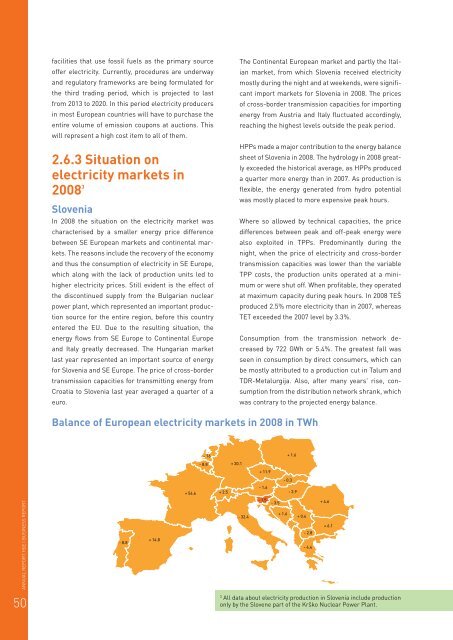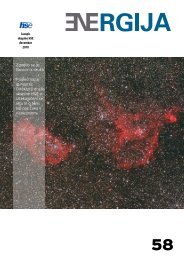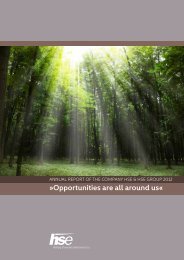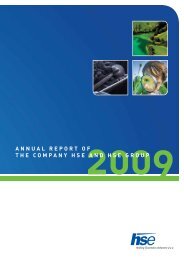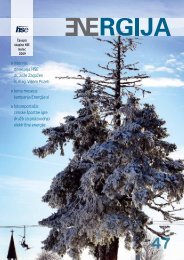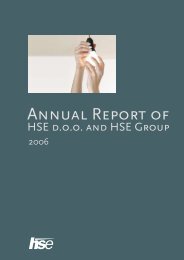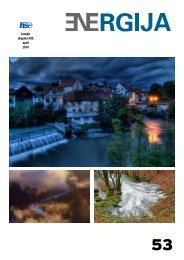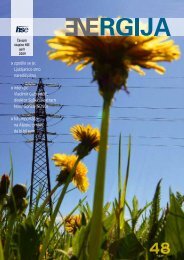ANNUAL REPORT - HSE
ANNUAL REPORT - HSE
ANNUAL REPORT - HSE
You also want an ePaper? Increase the reach of your titles
YUMPU automatically turns print PDFs into web optimized ePapers that Google loves.
facilities that use fossil fuels as the primary source<br />
offer electricity. Currently, procedures are underway<br />
and regulatory frameworks are being formulated for<br />
the third trading period, which is projected to last<br />
from 2013 to 2020. In this period electricity producers<br />
in most European countries will have to purchase the<br />
entire volume of emission coupons at auctions. This<br />
will represent a high cost item to all of them.<br />
2.6.3 Situation on<br />
electricity markets in<br />
2008 3<br />
Slovenia<br />
In 2008 the situation on the electricity market was<br />
characterised by a smaller energy price difference<br />
between SE European markets and continental markets.<br />
The reasons include the recovery of the economy<br />
and thus the consumption of electricity in SE Europe,<br />
which along with the lack of production units led to<br />
higher electricity prices. Still evident is the effect of<br />
the discontinued supply from the Bulgarian nuclear<br />
power plant, which represented an important production<br />
source for the entire region, before this country<br />
entered the EU. Due to the resulting situation, the<br />
energy flows from SE Europe to Continental Europe<br />
and Italy greatly decreased. The Hungarian market<br />
last year represented an important source of energy<br />
for Slovenia and SE Europe. The price of cross-border<br />
transmission capacities for transmitting energy from<br />
Croatia to Slovenia last year averaged a quarter of a<br />
euro.<br />
The Continental European market and partly the Italian<br />
market, from which Slovenia received electricity<br />
mostly during the night and at weekends, were significant<br />
import markets for Slovenia in 2008. The prices<br />
of cross-border transmission capacities for importing<br />
energy from Austria and Italy fluctuated accordingly,<br />
reaching the highest levels outside the peak period.<br />
HPPs made a major contribution to the energy balance<br />
sheet of Slovenia in 2008. The hydrology in 2008 greatly<br />
exceeded the historical average, as HPPs produced<br />
a quarter more energy than in 2007. As production is<br />
flexible, the energy generated from hydro potential<br />
was mostly placed to more expensive peak hours.<br />
Where so allowed by technical capacities, the price<br />
differences between peak and off-peak energy were<br />
also exploited in TPPs. Predominantly during the<br />
night, when the price of electricity and cross-border<br />
transmission capacities was lower than the variable<br />
TPP costs, the production units operated at a minimum<br />
or were shut off. When profitable, they operated<br />
at maximum capacity during peak hours. In 2008 TEŠ<br />
produced 2.5% more electricity than in 2007, whereas<br />
TET exceeded the 2007 level by 3.3%.<br />
Consumption from the transmission network decreased<br />
by 722 GWh or 5.4%. The greatest fall was<br />
seen in consumption by direct consumers, which can<br />
be mostly attributed to a production cut in Talum and<br />
TDR-Metalurgija. Also, after many years' rise, consumption<br />
from the distribution network shrank, which<br />
was contrary to the projected energy balance.<br />
Balance of European electricity markets in 2008 in TWh<br />
- 16<br />
+ 1.6<br />
- 8.8<br />
+ 30.1<br />
+ 11.9<br />
- 0.3<br />
<strong>ANNUAL</strong> <strong>REPORT</strong> <strong>HSE</strong> | BUSINESS <strong>REPORT</strong><br />
- 8.8<br />
+ 14.8<br />
+ 54.6<br />
+ 2.5<br />
- 32.4<br />
- 1.6<br />
- 1.5<br />
- 3.9<br />
- 3.5<br />
+ 1.6<br />
+ 0.4<br />
- 2.8<br />
- 4.4<br />
+ 4.6<br />
+ 6.1<br />
50<br />
3<br />
All data about electricity production in Slovenia include production<br />
only by the Slovene part of the Krško Nuclear Power Plant.


